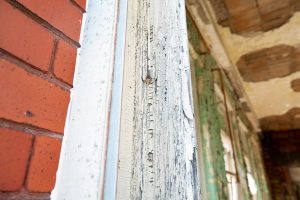What are the signs of lead poisoning in children?
 Lead poisoning has irreversible effects on children. Lead is a toxic metal found in many common items such as plumbing fixtures, water, some cosmetics, children’s toys, finger-paints, hair dye, contaminated soil, and much more.
Lead poisoning has irreversible effects on children. Lead is a toxic metal found in many common items such as plumbing fixtures, water, some cosmetics, children’s toys, finger-paints, hair dye, contaminated soil, and much more.
Children under the age of six years old are vulnerable to the toxic effects of lead exposure.
What are the signs of lead poisoning in children?
Lead poisoning symptoms present in children the same way viruses do, which is why lead poisoning is often misdiagnosed. When blood levels are extremely high, signs of lead poisoning can include the following:
- Headache
- Stomachache
- Nausea
- Irritability
- Fatigue
The health effects are long lasting and include serious damage to body systems.
Lead damage can cause:
- Lower intellectual functioning (lower IQ)
- Brain damage
- Liver and kidney damage
- Learning disabilities
What are the main sources of lead?
Old Paint
 Lead poses a danger inside and outside a house. Prior to 1978, many homes were painted with lead-based paint. Lead-based paint is unsafe when it peels, chips, or flakes. Naturally, young children touch everything in their environment and often swallow lead dust or chew paint chips.
Lead poses a danger inside and outside a house. Prior to 1978, many homes were painted with lead-based paint. Lead-based paint is unsafe when it peels, chips, or flakes. Naturally, young children touch everything in their environment and often swallow lead dust or chew paint chips.
Lead dust
When lead-based painted surfaces like window-sills or doors are subjected to a high volume of use, the chances for breathing in lead dust increase. Pregnant women who breathe in lead dust transmit lead to their unborn baby. This repeated exposure to high levels of lead leads to serious damage to the baby.
Soil
Parents often encourage their children to get outside, get dirty, and experience the natural world around them. Parents can often be overheard saying things like, “a little dirt won’t hurt them!” Well, in the case of lead contamination, a little dirt will do more than just “hurt them.” If consumed, lead causes serious long-term damage to children.
Children become exposed to contaminated soil when lead-paint chips off into soil. There’s even a risk of tracking soil into a home, further exposing other family members.
There are more problems associated with lead-contaminated soil than just exposure. Many people grow herbs, vegetables, or fruit in gardens close to their homes that may be planted in contaminated soil. When children regularly consume the tainted food, their bodies absorb the lead.
Water
 The CDC (Centers for Disease Control and Prevention) reports that the most common sources of lead in drinking water are lead pipes, faucets, and plumbing fixtures.
The CDC (Centers for Disease Control and Prevention) reports that the most common sources of lead in drinking water are lead pipes, faucets, and plumbing fixtures.
Because no safe blood level has been identified in children, it is best to have your water tested for lead by a certified lab.
What are some other sources of lead?
Toys
Lead may be found in older toys (passed down from one generation to the next) or antique toys that are sold in antique stores. The only accurate way to tell if a toy contains lead is to have it tested by a certified laboratory.
Unlike toys from other countries, toys that are manufactured in the United States are produced without lead.
Cosmetics
In December 2016, FDA (Food Drug Administration) issued draft guidance to industry on lead as an impurity in cosmetic lip products, such as lipsticks, and other cosmetics, such as eye shadows, blushes, compact powders, shampoos, and body lotions.
Since lead naturally occurs in the environment, its presence is unavoidable in cosmetic products. The determination is that there is an acceptable (low) level in these products that won’t pose a risk to humans. At 10 ppm (parts per million), the risk of exposure is so low that routine blood work can’t measure lead in the blood.
This is not to say that all cosmetics are safe. The FDA monitors cosmetics currently on the market and makes every effort to remove products that contain unacceptable levels of lead.
Workplace exposure (when brought into a living space)
 Lead exposure occurs in most industry sectors including construction, manufacturing, wholesale trade, transportation, remediation, and recreation.
Lead exposure occurs in most industry sectors including construction, manufacturing, wholesale trade, transportation, remediation, and recreation.
Construction workers are exposed during removal, renovation, or demolition of structures that contain lead.
Workers are also exposed to lead during the production of many items such as solder, plumbing fixtures, lead bullets, or rechargeable batteries to name a few.
People working in high-risk workplaces unknowingly bring home lead dust on their clothes. Since lead enters the body through inhalation and ingestion, children run the risk of being exposed.
How do I know if my child is exposed to lead?
A simple blood test can detect lead poisoning.
Currently, in the United States, blood lead tests are mandated for all children in 11 U.S. states and Washington, DC. In addition, Medicaid requires that one-third of all U.S. children enrolled in the program, which provides healthcare for low-income and disabled people, be tested at ages one and two.
Many will argue that there isn’t enough being done to screen children 2 years old and younger. A lack of universal lead poison testing for children has contributed to millions of children missing early lead blood tests.
Reach out to your child’s pediatrician for a lead screening or blood test if one is not mandated in the state you live in.
How can lead poisoning be prevented?
One way to prevent lead poisoning is through good nutrition. Adequate intake of iron, calcium, and vitamin c minimizes lead absorption in children’s bodies.
Another way to prevent lead poisoning is to have any suspicious surfaces tested for lead, especially if you live in an older home.
How can AMD Environmental help?
 AMD Environmental specializes in lead-based paint inspections and lead paint tests.
AMD Environmental specializes in lead-based paint inspections and lead paint tests.
Our company uses state of the art X-ray fluorescence (XRF), a HUD-specified method, for identifying lead-based paint in housing. XRF is fast and non-destructive and reads through multiple layers of paint (up to 3/8 of an inch) that may be built up on a surface.
We use an XRF Analyzer, and perform inspections on:
- Single and multi-family dwellings
- Apartment buildings
- Commercial properties
- Schools and daycare centers
- Medical offices
- Sites under construction
AMD Environmental can fulfill all of your lead paint test and inspection needs. We will help you understand and fulfill your obligations in a simple, timely, and cost-effective manner, whether you are:
- Aiming to comply with federal, state and city regulations governing lead-based paint
- Applying for homeowner’s insurance
- Seeking mortgage approval
- Concerned about lead exposure at your residence
Lead Based Paint Risk Assessments
A residential lead-based paint risk assessment will discover any lead-based paint hazards.
AMD Environmental lead paint risk assessments include:
- a visual inspection of the dwelling
- an assessment of building history, age, management, and maintenance of the dwelling
- the number of children under the age of 6 and women of childbearing age who reside or frequent the dwelling
- a sampling of deteriorated paint, dust and soil for testing in our lab
If you think your child has been exposed to lead or is exhibiting unusual symptoms, contact a pediatrician immediately for a blood test. If you’re unsure how your child was exposed or suspect lead containing materials in your home, contact AMD Environmental.


